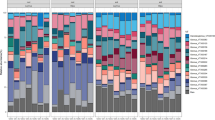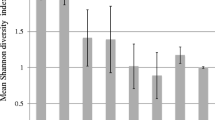Abstract
We studied the diversity of arbuscular mycorrhizal fungi (AMF) in semiarid grassland and the effect of long-term nitrogen (N) fertilization on this fungal community. Root samples of Bouteloua gracilis were collected at the Sevilleta National Wildlife Refuge (New Mexico, USA) from control and N-amended plots that have been fertilized since 1995. Small subunit rDNA was amplified using AMF specific primers NS31 and AM1. The diversity of AMF was low in comparison with other ecosystems, only seven operational taxonomic units (OTU) were found in B. gracilis and all belong to the genus Glomus. The dominant OTU was closely related to the ubiquitous G. intraradices/G. fasciculatum group. N-amended plots showed a reduction in the abundance of the dominant OTU and an increase in AMF diversity. The greater AMF diversity in roots from N-amended plots may have been the result of displacement of the dominant OTU, which facilitated detection of uncommon AMF. The long-term implications of AMF responses to N enrichment for plant carbon allocation and plant community structure remain unclear.





Similar content being viewed by others
References
Aerts R (2002) The role of various types of mycorrhizal fungi in nutrient cycling and plant competition. In: van der Heijden MGA, Sanders I (eds) Mycorrhizal ecology, ecologial etudies, vol 157. Springer-Verlag, Berlin, pp 117–133
Akiyama K, Matsuzaki K, Hayashi H (2005) Plant sesquiterpenes induce hyphal branching in arbuscular mycorrhizal fungi. Nature 435:824–827
Allen MF, Smith WK, Moore TS, Christensen M (1981) Comparative water relation and photosynthesis of mycorrhizal and non-mycorrhizal Bouteloua gracilis H.B.K Lag Ex Steud. New Phytol 88:683–693
Báez S, Fargione J, Moore DI, Collins SL, Gosz JR (2007) Atmospheric nitrogen deposition in the northern Chihuahuan desert: temporal trends and potential consequences. J Arid Environ 68:640–651
Barrow JR (2003) Atypical morphology of dark septate fungal root endophytes of Bouteloua in arid southwestern USA rangelands. Mycorrhiza 13:239–247
Bhadalung NN, Suwanarit A, Dell B, Nopamornbodi O, Thamchaipenet A, Rungchuang (2005) Effects of long-term NP-fertilization on abundance and diversity of arbuscular mycorrhizal fungi under a maize cropping system. Plant Soil 270:371–382
Bentivenga SP, Hetrick BAD (1992) Seasonal and temperature effect on mycorrhizal activity and dependence of cool-season and warm-season tallgrass prairie grasses. Can J Botany 70:1596–1602
Brachmann A (2006) Plant-fungal symbiosis en gros and en détail. New Phytol 171:246–248
Brachmann A, Parniske M (2006) The most widespread symbiosis on earth. PLoS Biol. 4, e239. DOI: 10.1317/journal.pbio.0040239
Bradley K, Drijber RA, Knops J (2006) Increased N availability in grassland soils modifies their microbial communities and decreases the abundance of arbuscular mycorrhizal fungi. Soil Biol. Biochem. 38:1583–1595
Corkidi L, Rowland DL, Johnson NC, Allen EB (2002) Nitrogen fertilization alters the functioning of arbuscular mycorrhizas at two semiarid grasslands. Plant Soil 240:299–310
DeBellis T, Widden P (2006) Diversity of the small subunit ribosomal RNA gene of the arbuscular mycorrhizal fungi colonizing Clintonia borealis from a mixed-wood boreal forest. FEMS Microbiol Ecol 58:225–235
Douds DD, Schenck NC (1990) Relationship of colonization and sporulation by VA mycorrhizal fungi to plant nutrient and carbohydrate contents. New Phytol 114:621–627
Egerton-Warburton LM, Allen EB (2000) Shifts in arbuscular mycorrhizal communities along an anthropogenic nitrogen deposition gradient. Ecol Appl 10:484–496
Egerton-Warburton LM, Graham RC, Allen EB, Allen MF (2001) Reconstruction of the historical changes in mycorrhizal fungal communities under anthropogenic nitrogen deposition. Proc R Soc Lond B 268:2479–2484
Eriksen M, Bjureke KE, Dhillion SS (2002) Mycorrhizal plants of traditionally managed boreal grasslands in Norway. Mycorrhiza 12:117–123
Erland S, Taylor AF S (2002) Diversity of Ecto-mycorrhizal fungal communities in relation to the abiotic environment. In: van der Heijden MGA, Sanders I. (eds) Mycorrhizal Ecology, Ecologial Studies, vol. 157. Springer-Verlag, Berlin, pp 163–200
Felsenstein J (2005) PHYLIP (Phylogeny Inference Package) version 3.6. Distributed by the author. Department of Genome Sciences, University of Washington, Seattle
Fitter AH, Heinemeyer A, Husband R, Olsen E, Ridgway KP, Staddon PL (2004) Global environmental change and the biology of arbuscular mycorrhizas: gaps and challenges. Can J Botany 82:1133–1139
Gai JP, Feng G, Cai XB, Christie P, Li XL (2002) A preliminary survey of the arbuscular mycorrhizal status of grassland plants in southern Tibet. Mycorrhiza 16:191–196
Gardes M, Bruns TD (1993) ITS primers with enhanced specificity of basidiomycetes: application to the identification of mycorrhizae and rusts. Mol Ecol 2:113–118
Gosz RJ, Gosz JR (1996) Species interactions on the bioma transition zone in New Mexico: response of blue grama (Bouteloua gracilis) and black grama (Bouteloua eriopoda) to fire and herbivory. J Arid Environ 34:101–114
Govindarajulu M, Pfeffer PE, Jin H, Abubaker J, Douds DD, Allen JW, Bücking H, Lammers PJ, Shachar-Hill Y (2005) Nitrogen transfer in the arbuscular mycorrhizal symbiosis. Nature 435:819–823
Grulke NE, Andersen CP, Fenn ME, Miller PR (1998) Ozone exposure and nitrogen deposition lowers root biomass of ponderosa pine in the San Bernardino Mountains, California. Environ Pollut 103:63–73
Hartnett DC, Wilson GWT (1999) Mycorhizae influence plant community structure and diversity in tallgrass prairie. Ecology 80:1187–1195
Hawkes CV, Belnap J, D’Antonio C, Firestone MK (2006) Arbuscular mycorrhizal assemblages in native plant roots change in the presence of invasive exotic grasses. Plant Soil 281:369–380
Helgason T, Daniell TJ, Husband R, Fitter AH, Young JPW (1998) Ploughing up the wood-wide web? Nature 394:431
Helgason T, Fitter AH, Young JPW (1999) Molecular diversity of arbuscular mycorrhizal fungi colonizing Hyacinthoides non-scripta (bluebell) in a seminatural woodland. Mol Ecol 8:659–666
Husband R, Herre EA, Turner SL, Gallery R, Young JPW (2002) Molecular diversity of arbuscular mycorrhizal fungi and patterns of host association over time and space in a tropical forest. Mol Ecol 12:2669–2678
Johnson NC (1993) Can fertilizatioin of soil select less mutualistic mycorrhizae? Ecol Appl 3:749–757
Johnson NC, Rowland DL, Corkidi L, Egerton-Warburton LM, Allen EB (2003) Nitrogen enrichment alters mycorrhizal allocation at five mesic to semiarid grasslands. Ecology 84:1895–1908
Jumpponen A, Trowbridge J, Mandyam K, Johnson L (2005) Nitrogen enrichment causes minimal changes in arbuscular mycorrhizal colonization but shifts community composition-evidence from rDNA data. Biol Fert Soils 41:217–224
Koch AM, Kuhn G, Fontanillas P, Fumagalli L, Goudet I, Sanders IR (2004) High genetic variability and low local diversity in a population of arbuscular mycorrhizal fungi. P Natl Acad Sci USA 101:2369–2374
Koch AM, Croll D, Sanders IR (2006) Genetic variability in a population of arbuscular mycorrhizal fungi causes variation in plant growth. Ecol Lett 9:103–110
Li LF, Yang A, Zhao ZW (2005) Seasonality of arbuscular mycorrhizal symbiosis and dark septate endophytes in a grassland site in southwest China. FEMS Microbiol Ecol 54:367–373
Lozupone C, Knight R (2005) UniFrac: a new phylogenetic method for comparing microbial communities. Appl Environ Microb 71:8228–8235
Munkvold L, Kjøller R, Vestberg M, Rosendahl S, Jakobsen I (2004) High functional diversity within species of arbuscular mycorrhizal fungi. New Phytol 164:357–364
O’Brien HE, Parrent JL, Jackson JA, Moncalvo J, Vilgalys R (2005) Fungal community analysis by large-scale sequencing of environmental samples. Appl Environ Microb 71:5544–5550
Olsson PA, Burleigh SH, van Aarle IM (2005) The influence of external nitrogen on carbon allocation to Glomus intraradices in monoxenic arbuscular mycorrhiza. New Phytol 168:677–686
Öpik M, Moora M, Liira J, Kõljalg U, Zobel M, Sen R (2003) Divergent arbuscular mycorrhizal fungal communities colonize roots of Pulsatilla spp. in boreal Scots pine forest and grassland soils. New Phytol 160:581–593
Öpik M, Moora M, Liira J, Zobel M (2006) Composition of root-colonizing arbuscular mycorrhizal fungal communities in different ecosystems around the globe. J Ecol 94:778–790
Redecker D (2000) Specific PCR primers to identify arbuscular mycorrhizal fungi within colonized roots. Mycorrhiza 10:73–80
Rillig M, Treseder KK, Allen MF (2002) Global change and mycorrhizal fungi. In: van der Heijden MGA, Sanders I. (eds) Mycorrhizal Ecology, Ecologial Studies, vol. 157. Springer-Verlag, Berlin, pp 135–160
Rosendahl S, Stukenbrock EH (2004) Community structure of arbuscular mycorrhizal fungi in undisturbed vegetation revealed by analyses of LSU rDNA sequences. Mol Ecol 13:3179–3186
Santos JC, Finlay RD, Tehler A (2006) Molecular analysis of arbuscular mycorrhizal fungi colonizing a semi-natural grassland along a fertilization gradient. New Phytol 172:159–168
Schloss PD, Handelsman J (2005) Introducing DOTUR a computer program for defining operational taxonomic units and estimating species richness. Appl Environ Microb 71:1501–1506
Schüβler A, Gehrig H, Schwarzott D, Walker C (2001) Analysis of partial Glomales SSU rRNA gene sequences: implications for primer design and phylogeny. Mycol Res 105:5–15
Schwarzott D, Walker C, Schüßler A (2001) Glomus, the largest genus of the arbuscular mycorrhizal fungi (Glomales), is nonmonophyletic. Mol Phylogenet Evol 21:190–197
Schlesinger WH, Reynolds JF, Cunningham GL, Huenneke LF, Jarrell W M,Virginia RA, Whitford WG (1990) Biological Feedbacks in Global Desertification. Science 247:1043–1048
Simon L, Lalonde M, Bruns TD (1992) Specific amplification of 18S fungal ribosomal genes from VA endomycorrhizal fungi colonizing roots. Appl Environ Microb 58:291–295
Smith SE, Read DJ (1997) Mycorrhizal Symbiosis. Academic Press, London, UK, p. 605
Stevens CJ, Dise NB, Mountford JO, Gowing DJ (2004) Impact of nitrogen deposition on the species richness of grasslands. Science 303:1876–1879
Stukenbrock EH, Rosendahl S (2005) Distribution of dominant arbuscular mycorrhizal fungi among five plant species in undisturbed vegetation of coastal grassland. Mycorrhiza 15:497–503
Stursova M, Crenshaw CL, Sinsabaugh RL (2006) Microbial Responses to Long-Term N Deposition in a Semiarid Grassland. Microb Ecol 51:90–98
Swofford D (2002) Phylogenetic Analysis Using Parsimony (*and Other Methods), Version 4. Sinauer Associates, Sunderland, MA, USA
Tu C, Booker FL, Watson DM, Chen X, Rufty TW, Shi W, Hu S (2006) Mycorrhizal mediation of plant N acquisition and residue decomposition: Impact of mineral N inputs. Glob Change Biol 12:793–803
Vallino M, Massa N, Lumini E, Bianciotto V, Berta G, Bonfante P (2006) Assessment of arbuscular mycorrhizal fungal diversity in roots of Solidago gigantea growing in a polluted soil in Northern Italy Environ. Microb 8:971–983
Vandenkoornhuyse P, Husband R, Daniell TJ, Watson IJ, Duck JM, Fitter AH, Young JPW (2002) Arbuscular mycorrhizal community composition associated with two plant species in a grassland ecosystem. Mol Ecol 11:1555–1564
van der Heijden MGA, Boller T, Wiemken A, Sanders IR (1998) Different arbuscular mycorrhizal fungal species are potential determinants of plant community structure. Ecology 79:2082–2091
van der Heijden MGA, Klironomos JN, Ursic M, Moutoglis P, Streitwolf-Engel R, Boller T, Wiemken A, Sanders IR (1998a) Mycorrhizal fungal diversity determines plant biodiversity, ecosystem variability and productivity. Nature 396:69–72
van der Heijden MGA (2004) Arbuscular mycorrhizal fungi as support systems for seedling establishment in grassland. Ecol Lett 7:293–303
van der Heijden MGA, Streitwolf-Engel R, Riedl R, Siegrist S, Neudecke A, Ineichen K, Boller T, Wiemken A, Sanders IR (2006) The mycorrhizal contribution to plant productivity, plant nutrition and soil structure in experimental grassland. New Phytol 172:739–752
Vierheilig H, Piche Y (1998) A modified procedure for staining arbuscular mycorrhizal fungi in roots. Z Fur Pflanz Bodenkunde 161:601–602
Vitousek PM, Aber JD, Howarth RW, Likens GE, Matson PA, Schindler DW, Schlesinger WH, Tilman DG (1997) Technical report: human alteration of the global nitrogen cycle: sources and consequences. Ecol Appl 7:737–750
Wirsel SGR (2004) Homogenous stands of a wetland grass harbor diverse consortia of arbuscular mycorrhizal fungi. FEMS Microbiol Ecol 48:129–138
Acknowledgements
We would like to thank Kendra Lipinsky and William H. Dvorachek for their help processing the samples, Esteban Araya for writing the program to organize the sequence database and technical assistance with Linux, and George Rosenberg for assistance with the sequencing and databases. This research was supported by the National Science Foundation Long Term Ecological Research Program at the Sevilleta National Wildlife Refuge (DEB-0217774) and a grant from National Science Foundation Ecosystem Sciences Program (DEB 0516113).
Author information
Authors and Affiliations
Corresponding author
Additional information
Section editor: Peter Christie
Rights and permissions
About this article
Cite this article
Porras-Alfaro, A., Herrera, J., Natvig, D.O. et al. Effect of long-term nitrogen fertilization on mycorrhizal fungi associated with a dominant grass in a semiarid grassland. Plant Soil 296, 65–75 (2007). https://doi.org/10.1007/s11104-007-9290-9
Received:
Accepted:
Published:
Issue Date:
DOI: https://doi.org/10.1007/s11104-007-9290-9




